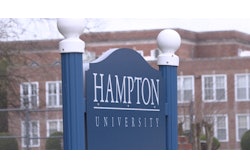Brown University’s groundbreaking 2006 report on the ways in which it has benefitted from the slave trade is getting an update. The university announced the release of an expanded second edition, including essays reflecting on the report’s impact from current and former scholars at Brown, university leaders, and alumni.
Dr. Anthony Bogues, the Asa Messer Professor of Humanities and Critical Theory, and a professor of Africana Studies at Brown, said that the time was right. “It was coming up to 15 years [since the original publication], and there’s a great national conversation [about] our racial reckoning in the United States," said Bogues, who is also the director of the Center for  Dr. Anthony Bogues,the Study of Slavery and Justice at Brown and the editor of the new edition of the report. "Those things created a moment [when] we thought the report should be re-issued.”
Dr. Anthony Bogues,the Study of Slavery and Justice at Brown and the editor of the new edition of the report. "Those things created a moment [when] we thought the report should be re-issued.”
The second edition is available both as a printed book and an open-access interactive website, which allows users to zoom in on photos, illustrations, and documents, and to read transcripts. This allows for close examination of artifacts like building records from Brown’s University Hall, showing that it was built with donated slave labor and a bill of landing for a slave ship sent by the Brown brothers.
However, slavery was hardly mentioned in Brown’s official history in 2003, when then-University President Dr. Ruth J. Simmons announced the formation of a Steering Committee to report on the school’s relationship to the slave trade. The move was controversial, to say the least. “You disgust me, as you disgust many other Americans,” read one letter to the committee.
The committee’s findings were surprising. They concluded that, despite Brown’s status as a northern school with a history of anti-slavery thought, “there is no question that many of the assets that underwrote the University’s creation and growth derived, directly and indirectly, from slavery.”
Brown’s ties to the slave trade ranged from the members of its governing body to the donors to its first endowment campaign. Even an antique clock in the office where the Steering Committee met turned out to have been owned by a former slave ship captain and Brown Trustee. The report ended with recommendations for how the university could make up for its “entanglement” with slavery.
Public reaction to the report was much more positive than to the committee’s formation. Brown’s public reckoning inspired a national dialogue about how institutions have benefitted from slavery, and approximately 100 schools embarked on their own similar projects. Brown’s work also inspired the creation of the Universities Studying Slavery Consortium at the University of Virginia, an international group of over 75 schools devoted to addressing slavery and racism in institutional histories.
Some of the second edition’s new material reflects on the report’s impacts, both on Brown’s campus and off of it. The university followed many of the report’s recommendations. These included a formal public acknowledgment of the university’s culpability, correction of the official university history, creation of an on-campus memorial, the establishment of Brown’s Center for the Study of Slavery and Justice (CSSJ), and investments in programs to help Rhode Island’s K-12 public schools.
But the second edition also makes clear that there is still much work to be done.
“Re-reading the Slavery and Justice Report in 2021, I am struck by…the expectation that a full, honest engagement with the American past would facilitate a different and better American future. This was perhaps…unduly optimistic,” writes Dr. Seth Rockman, an associate professor of History. Rockman’s essay points out that even after the report’s publication, the percentage of Black faculty and students at Brown remains in the single digits.
Dr. Emily A. Owens, an assistant professor of History, wondered if the report was enough to spur further meaningful action.
“Have our students, and our community at large, come to know just enough about the University’s relationship with slavery to be comfortable?” she asks in her essay. Owens’s essay proposes that the CSSJ offer an undergraduate course on how institutions have supported slavery throughout history and that CSSJ host a year-long residential fellowship program.
While the new edition of the report acknowledges how the conversation has shifted since the original report’s publication, none of the new material addresses a racial justice proposal favored by an overwhelming majority of Brown’s undergraduates: reparations. This past spring, in a referendum put forward by Brown's Undergraduate Council of Students, 85% of voters agreed that Brown should attempt to identify the descendants of African slaves who were affected by the university and give them reparations.
“I believe that it is a missed opportunity,” said Zanagee Artis, a senior at Brown and one of the drafters of the referendum. “They’ll be applauded by many for the work that they’re doing on this now, but it leaves out what the students actually asked for.”
In response, Bogues points out that Simmons explicitly excluded recommending reparations from the Steering Committee’s original mission and argues that the second edition of the report is not the place to do so.
“The question of reparations to me demands not an article in a book, but really demands a set of conversations between the university and the community,” he said.
Although it doesn’t go as far as some students may have hoped, the second edition of Brown’s report offers the opportunity for readers to re-engage with the issues raised by institutions’ historical relationships to slavery. It is an opportunity that many of the new edition’s essayists hope will lead to renewed efforts towards racial justice.
As James T. Campbell, the Edgar E. Robinson Professor in U.S. History at Stanford University and the chairperson of Brown’s Steering Committee on Slavery and Justice, writes: “The question now is what do we do with this new historical openness? ... Our real work is just beginning.”















